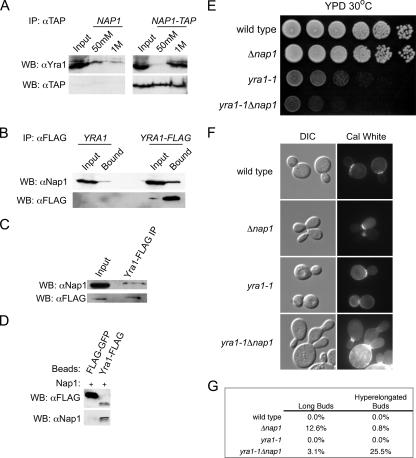FIG. 1.
Nap1 interacts directly with Yra1. (A) Whole-cell lysates from a Nap1-TAP (right panel) and an untagged strain (left panel) were incubated with IgG Sepharose. Interacting proteins were eluted with the indicated MgCl2 concentrations. Yra1 and Nap1-TAP were detected by Western blotting (WB). (B) Whole-cell lysates from a Yra1-FLAG-tagged (right panel) and an untagged strain (left panel) were incubated with anti-FLAG resin. Bound proteins were analyzed by Western blotting with the indicated antibodies. (C) Yra1-FLAG was immunoisolated from whole-cell extract made from formaldehyde-fixed cells. Coprecipitating Nap1 was detected by Western blotting. (D) Immobilized FLAG-GFP or Yra1-FLAG (250 nM) was incubated with Nap1 (250 nM). Complexes were analyzed by SDS-PAGE and Western blotting with FLAG and Nap1 antibodies. (E) Strains of the indicated genotype were equalized, spotted at 10-fold serial dilutions, and grown on YPD plates at 30°C for 2 days. (F) Strains of the indicated genotype were stained with calcofluor white (Cal White) and visualized by fluorescence and differential interference contrast microscopy. (G) The frequency of long and hyperelongated buds relative to normal buds in asynchronous populations of cells was determined. The length of long buds was approximately greater than the width, but not did not exceed the mother cell diameter. The length of hyperelongated buds was approximately greater than both the bud width and mother cell diameter. A minimum of 175 cells were characterized.

